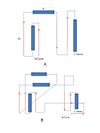Sandbox Reserved 186
From Proteopedia
(Difference between revisions)
| Line 11: | Line 11: | ||
== GPx-1 and Disease == | == GPx-1 and Disease == | ||
| - | Because of its role as an anti-oxidant, deficiencies in GPx-1 have been linked to the pathogenesis of multiple diseases. These diseases include cancers, neurodegenerative diseases, heart disease, and diabetes (4). The Pathogenisis of these diseases have been linked to the presences of excessive reactive oxygen species (ROS)(7). One major oxidant is hydrogen peroxide which has been shown to oxidatively modify proteins and DNA bases as well as induce single and double stranded DNA breaks ( | + | Because of its role as an anti-oxidant, deficiencies in GPx-1 have been linked to the pathogenesis of multiple diseases. These diseases include cancers, neurodegenerative diseases, heart disease, and diabetes (4). The Pathogenisis of these diseases have been linked to the presences of excessive reactive oxygen species (ROS)(7,8). One major oxidant is hydrogen peroxide which has been shown to oxidatively modify proteins and DNA bases as well as induce single and double stranded DNA breaks (9,10). Deficiencies in GPx-1 could result in excessive hydrogen peroxide and thus cellular damage giving rise to these disorders. |
== Other Proteins with a thioredoxin like fold == | == Other Proteins with a thioredoxin like fold == | ||
| - | Proteins that have a thioredoxin like fold are involved in catalyzing reduction, oxidation, or disulfide bond exchanges ( | + | Proteins that have a thioredoxin like fold are involved in catalyzing reduction, oxidation, or disulfide bond exchanges (11). Thioredoxin is the protein after which the fold is named and is an important redox protein. Glutaredoxins are another class of proteins that have a thioredoxin like fold and are distantly related to thioredoxin. This family of proteins are also involved in maintaining the redox state of the cytosol (12). A third class of proteins with this fold are the disulfide oxidoreductases which are involved in catalyzing the formation of disulfide bonds and play an important role in protein folding (12). Glutathione peroxidases also have a thioredoxin like fold and are involved in the reduction of various oxidants which helps to modulate the intracellular redox state. Peroxyredoxins are also involved in the regulation of the intracellular redox state as they reduce various peroxides. A final class of proteins that contain a thioredoxin like fold are the glutathione-s-transferases which catalyze the transfer of glutathione to various substrates and which is an important step in the metabolism of various molecules (12). |
== References == | == References == | ||
| Line 28: | Line 28: | ||
6.Atkinson HJ, Babbitt PC (2009). An atlas of the thioredoxin fold class reveals the complexity of function-enabling adaptations. PLOS computational biology, epub. | 6.Atkinson HJ, Babbitt PC (2009). An atlas of the thioredoxin fold class reveals the complexity of function-enabling adaptations. PLOS computational biology, epub. | ||
| + | |||
| + | 7. Reuter S, Gupta SC, Chaturvedi MM, Aggarwal, BB (2010). Oxidative stress, inflammation and cancer: how are they linked? Free Radical Biology and Medicine 49, 1603-1616. | ||
| + | |||
| + | 8. Barnham KJ, Masters CL, Bush AI (2004). Neurodegenerative diseases and oxidative stress. Nature Reviews Drug Discovery 3, 205-214. | ||
Revision as of 13:31, 30 April 2014
| |||||||||||




